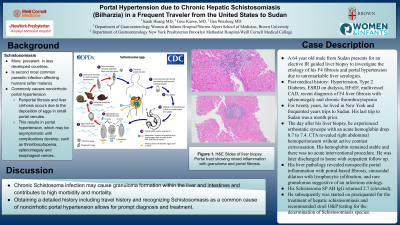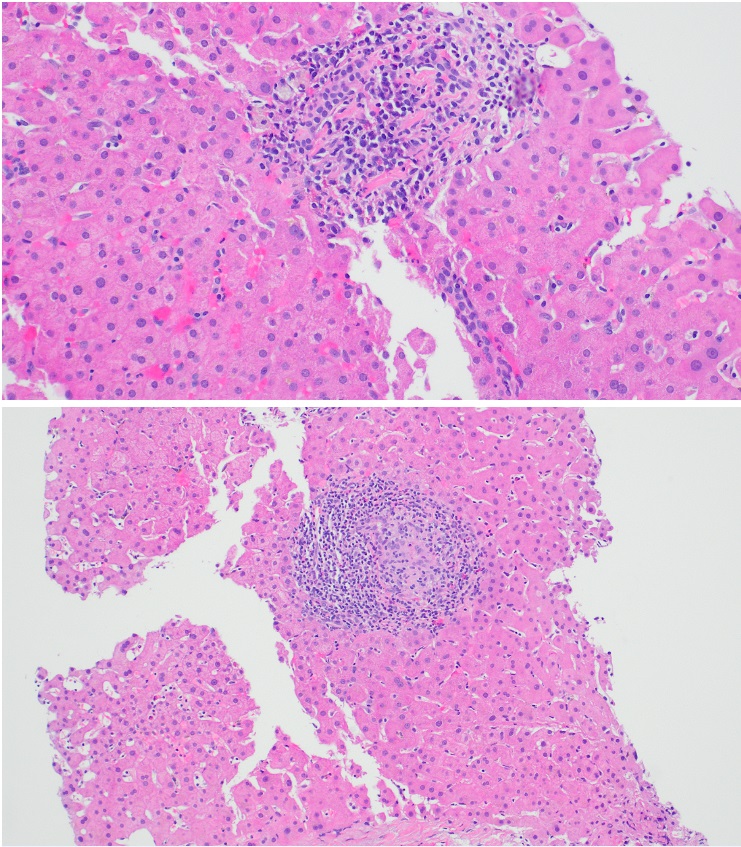Sunday Poster Session
Category: Liver
P1422 - Portal Hypertension Due to Chronic Hepatic Schistosomiasis (Bilharzia) in a Frequent Traveler from the United States to Sudan
Sunday, October 27, 2024
3:30 PM - 7:00 PM ET
Location: Exhibit Hall E

Has Audio
.jpg)
Sarah Huang, MD
New York-Presbyterian / Brooklyn Methodist Hospital
Brooklyn, NY
Presenting Author(s)
Sarah Huang, MD1, Gres Karim, MD2, Ilan Weisberg, MD2
1New York-Presbyterian / Brooklyn Methodist Hospital, Brooklyn, NY; 2New York-Presbyterian Brooklyn Methodist Hospital, Brooklyn, NY
Introduction: Uncommon in the United States and with a prevalence in less developed countries, Schistosomiasis is the second most common parasitic infection affecting humans (after malaria). It commonly causes noncirrhotic portal hypertension. Periportal fibrosis and liver cirrhosis occurs due to the deposition of eggs in small portal venules. This results in portal hypertension which may be asymptomatic until complications develop, such as thrombocytopenia, splenomegaly and esophageal varices.
Case Description/Methods: A 64 year old male from Sudan with a past medical history of Hypertension, Type 2 Diabetes, ESRD on dialysis, HFrEF, multivessel CAD, recent diagnosis of liver fibrosis with splenomegaly and chronic thrombocytopenia presented for an elective IR guided liver biopsy. In the outpatient setting, he was found to have F4 fibrosis on Fibroscan, and was referred for a liver biopsy to investigate the etiology of his fibrosis and portal hypertension. For twenty years, he lived in New York and frequented years trips to Sudan. His last trip to Sudan was a month prior. Fib-4 Score was 5.83. Viral hepatitis panel was negative for acute hepatitis. HIV was non-reactive. The day after his liver biopsy, he experienced dizziness with an acute hemoglobin drop 8.7 to 7.4, with orthostatics positive vital signs. A CTA was performed and revealed right abdominal hemoperitoneum without active contrast extravasation. His hemoglobin remained stable and there was no acute interventional procedure. He was later discharged to home with outpatient follow up. His liver pathology revealed nonspecific portal inflammation with portal-based fibrosis, sinusoidal dilation with lymphocytic infiltration, and rare granulomas suggestive of an infectious etiology. His Schistosoma SP AB IgG returned 2.7 (elevated). He subsequently was started on praziquantel for the treatment of hepatic schistosomiasis and recommended stool O&P testing for the determination of Schistosomiasis species.
Discussion: Chronic Schistosoma infection may cause granuloma formation within the liver and intestines and contributes to high morbidity and mortality. Obtaining a detailed history including travel history and recognizing Schistosomiasis as a common cause of noncirrhotic portal hypertension allows for prompt diagnosis and treatment.

Disclosures:
Sarah Huang, MD1, Gres Karim, MD2, Ilan Weisberg, MD2. P1422 - Portal Hypertension Due to Chronic Hepatic Schistosomiasis (Bilharzia) in a Frequent Traveler from the United States to Sudan, ACG 2024 Annual Scientific Meeting Abstracts. Philadelphia, PA: American College of Gastroenterology.
1New York-Presbyterian / Brooklyn Methodist Hospital, Brooklyn, NY; 2New York-Presbyterian Brooklyn Methodist Hospital, Brooklyn, NY
Introduction: Uncommon in the United States and with a prevalence in less developed countries, Schistosomiasis is the second most common parasitic infection affecting humans (after malaria). It commonly causes noncirrhotic portal hypertension. Periportal fibrosis and liver cirrhosis occurs due to the deposition of eggs in small portal venules. This results in portal hypertension which may be asymptomatic until complications develop, such as thrombocytopenia, splenomegaly and esophageal varices.
Case Description/Methods: A 64 year old male from Sudan with a past medical history of Hypertension, Type 2 Diabetes, ESRD on dialysis, HFrEF, multivessel CAD, recent diagnosis of liver fibrosis with splenomegaly and chronic thrombocytopenia presented for an elective IR guided liver biopsy. In the outpatient setting, he was found to have F4 fibrosis on Fibroscan, and was referred for a liver biopsy to investigate the etiology of his fibrosis and portal hypertension. For twenty years, he lived in New York and frequented years trips to Sudan. His last trip to Sudan was a month prior. Fib-4 Score was 5.83. Viral hepatitis panel was negative for acute hepatitis. HIV was non-reactive. The day after his liver biopsy, he experienced dizziness with an acute hemoglobin drop 8.7 to 7.4, with orthostatics positive vital signs. A CTA was performed and revealed right abdominal hemoperitoneum without active contrast extravasation. His hemoglobin remained stable and there was no acute interventional procedure. He was later discharged to home with outpatient follow up. His liver pathology revealed nonspecific portal inflammation with portal-based fibrosis, sinusoidal dilation with lymphocytic infiltration, and rare granulomas suggestive of an infectious etiology. His Schistosoma SP AB IgG returned 2.7 (elevated). He subsequently was started on praziquantel for the treatment of hepatic schistosomiasis and recommended stool O&P testing for the determination of Schistosomiasis species.
Discussion: Chronic Schistosoma infection may cause granuloma formation within the liver and intestines and contributes to high morbidity and mortality. Obtaining a detailed history including travel history and recognizing Schistosomiasis as a common cause of noncirrhotic portal hypertension allows for prompt diagnosis and treatment.

Figure: Portal tract showing mixed inflammation with granuloma and portal fibrosis.
Disclosures:
Sarah Huang indicated no relevant financial relationships.
Gres Karim indicated no relevant financial relationships.
Ilan Weisberg indicated no relevant financial relationships.
Sarah Huang, MD1, Gres Karim, MD2, Ilan Weisberg, MD2. P1422 - Portal Hypertension Due to Chronic Hepatic Schistosomiasis (Bilharzia) in a Frequent Traveler from the United States to Sudan, ACG 2024 Annual Scientific Meeting Abstracts. Philadelphia, PA: American College of Gastroenterology.
